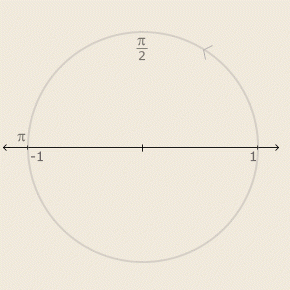The Transcendence of π
Here is what is simple about pi: if a circle measures 1 unit across, then it measures
π units around. Pi is defined just as the ratio of circumference to diameter:
π = C / D.
Here is what is infinitely complicated about pi: its value cannot be found in any of the foregoing number systems. It is not among the rationals, since no ratio of any two integers is equal to it. Nor is it the the square root of any number, nor the cube root or higher, nor sum, difference or ratio of any number, root or power. There is no finite series of any mathematical calculations on the number line, however long or involved, that will ever equal pi. Put another way, it is impossible to construct a line segment of length π.
On the other hand — to return to simplicity — it is trivial to construct a curved line with a length of π: measure a length of 1 on the number line, and make a circle with its center at 0. You now have a circle with a diameter of 2. Its circumference is 2π. Stop with a semicircle, and you have π exactly.
